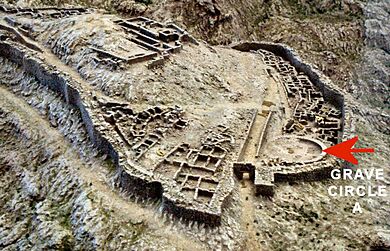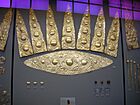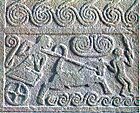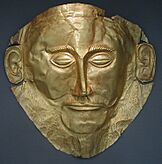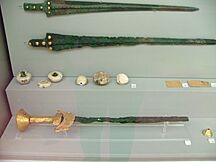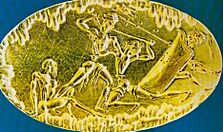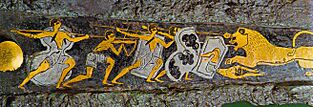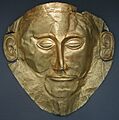Grave Circle A, Mycenae facts for kids
Quick facts for kids Grave Circle A |
|
|---|---|
| Native name Greek: Ταφικός περίβολος A' |
|
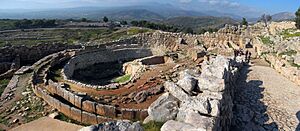
Grave Circle A (left) and the main entrance of the citadel (right)
|
|
| Location | Mycenae |
| Area | Argolis, Greece |
| Formed | 16th century BC |
| Built for | Resting place of the Mycenaean ruling families |
| Lua error in Module:Location_map at line 420: attempt to index field 'wikibase' (a nil value). | |
Grave Circle A is an ancient royal cemetery from the 16th century BC. It is located in southern Greece, near the main entrance of the old city of Mycenae. This city was a powerful center during the Bronze Age.
The burial site was first built outside the city walls. Later, around the 13th century BC, the city's defenses were made bigger. This brought Grave Circle A inside the acropolis, which is like a fortified hilltop city. Grave Circle A, along with Grave Circle B, are important examples of the early Mycenaean civilization.
The circular area is about 27.5 meters (90 feet) across. Inside, there are six special graves called shaft graves. These are like deep pits where people were buried. The largest shaft grave is about 6.5 meters (21 feet) long and 4.1 meters (13 feet) wide.
Archaeologists found a total of nineteen bodies here. These included men, women, and children. Each shaft grave held between two and five bodies. It is believed that a small hill was built over each grave. Also, tall stone slabs called stelae were put up to mark the graves.
Many amazing treasures were found as funerary gifts with the bodies. These included gold death masks, full sets of weapons, fancy staffs, gold jewelry, and cups made of gold and silver. The gifts found here are much more valuable than those from Grave Circle B. Experts think Grave Circle A held about 15 kilograms (33 pounds) of gold in total.
The site was excavated by archaeologist Heinrich Schliemann in 1876. He was helped by Panagiotis Stamatakis. Schliemann was inspired by old writings from Homer and Pausanias. One famous gold death mask he found is known as the "Death Mask of Agamemnon." Agamemnon was a legendary king of Mycenae in Greek mythology. However, we now know that the burials are much older. They happened about three centuries before Agamemnon was thought to have lived.
The valuable treasures found in these graves suggest that very powerful rulers were buried here. Even though Agamemnon lived much later, these graves might have belonged to an earlier royal family of Mycenae. In Greek myths, this family was called the Perseids. Later myths also suggest that Mycenae sometimes had two kings ruling at once. Archaeologists think that some of these graves, which held two bodies, might have been for these dual kings.
Contents
Mycenae's Early History
Around 2200 BC, the people living in mainland Greece experienced big changes. These changes were due to things like climate shifts and contact with other cultures. These early Bronze Age people were skilled and had horses. They also owned fancy goods and built impressive shaft graves.
The city of Mycenae became one of the most important centers of the Mycenaean culture. It was built on a hill that was easy to defend, about 128 meters (420 feet) high. The city covered an area of about 30,000 square meters (323,000 square feet). The shaft graves found at Mycenae show that a powerful Greek-speaking royal family rose to power here. Their wealth came from trading by sea over long distances.
Building and Changes Over Time
Mycenaean shaft graves were a special type of burial. They were based on older traditions from mainland Greece. Grave Circle A was created around 1600 BC as a new, important burial place for the elite. It seems to have continued from the earlier Grave Circle B. This also fits with a general trend across Greece at the time, where more effort was put into burials.
During the early Mycenaean period (around 1600 BC), Mycenae might have had a small palace without strong walls. The royal family's graves, including Grave Circle A, were still outside the city walls. There is no sign of a circular wall around the grave site during this time. The last burial in Grave Circle A happened around 1500 BC.
Soon after the last burials, the rulers stopped using shaft graves. They started using a new, more impressive type of tomb called a tholos. These were large, round, beehive-shaped tombs.
Around 1250 BC, the city of Mycenae expanded its fortifications. This meant Grave Circle A was now inside the new city wall. A double circular wall, called a peribolos, was also built around the grave area. It seems the site became a temenos, which means a sacred area. A circular structure, possibly an altar, was found above one of the graves. The burial site was redesigned as a monument. This was likely an effort by the 13th-century BC rulers to connect themselves to the heroic past of the older royal family. As part of this, the ground was leveled for ceremonies, and the stelae were put back up. A new main entrance to the city, the Lion Gate, was built close to the site.
Amazing Discoveries
Grave Circle A is located on the acropolis of Mycenae, near the Lion Gate. It holds six shaft graves. These graves range in size, with the smallest being about 3.0 by 3.5 meters and the largest about 4.5 by 6.4 meters. The depth of each grave is between 1.0 and 4.0 meters. As mentioned, a mound was built over each grave, and stelae were placed there. These stelae likely honored the Mycenaean rulers buried below. Three of them even show scenes of chariots.
Archaeologists found a total of nineteen bodies in the shafts. These included eight men, nine women, and two children. Most shafts held two to five bodies. However, Grave II had only one burial. Between Graves IV and V, five gold masks were found. This included the famous Mask of Agamemnon from Grave V. Boars' tusks were found in Grave IV. Many gold and silver cups were also discovered, including a special drinking vessel called the Silver Siege Rhyton. Several gold rings, buttons, and bracelets were also among the finds.
Most of the graves contained full sets of weapons, especially swords. The pictures on these objects often show fighting and hunting scenes. The gender of the people buried was often guessed based on the items found with them. Men were usually buried with weapons, while women had jewelry.
Many objects were designed to show the high social status of the person who died. For example, some daggers were beautifully decorated. They were more like art objects than actual weapons. Fancy staffs and a scepter from Grave IV clearly show that the buried person was very important.
Some items, like bulls' heads with a double-axe, show clear influences from the Minoan civilization. The Minoans lived on the island of Crete. At the time Grave Circle A was built, the Mycenaeans had not yet conquered Minoan Crete. It seems they admired the Minoans for their excellent designs and craftsmanship. Most of the objects in Grave Circle A were decorated in the Minoan style. However, some designs, like fighting and hunting scenes, were clearly Mycenaean. The mix of luxury goods found here shows an "international style." This means different cultures shared basic ideas and then changed them to fit their own art styles.
Excavating the Past
Mycenae was the first place in Greece to have a modern archaeological excavation. The German archaeologist Heinrich Schliemann started digging there in 1876. He worked with Panagiotis Stamatakis, a Greek archaeologist. Schliemann was inspired by Homer's epic poem, the Iliad, which described Mycenae as a city "abounding in gold."
He also followed the writings of an ancient geographer named Pausanias. Pausanias described the once-rich site and mentioned a local story from the 2nd century AD. This story claimed that the grave of Agamemnon was inside the citadel. It supposedly held Agamemnon, his charioteer Eurymedon, and the two children of Cassandra.
What Schliemann found in Grave Circle A made him very happy. It seemed to prove Homer's stories and satisfied his desire for valuable treasures. Among the items he dug up were several gold death masks. He famously called one of them "The Death Mask of Agamemnon." Schliemann cleared five shaft graves. He believed he had found all the graves mentioned by Pausanias and stopped digging. However, a year later, Stamatakis found a sixth shaft grave.
Since then, experts have shown that the burials in Grave Circle A are from the 16th century BC. This is much earlier than the traditional time of the Trojan War (13th-12th century BC). So, Agamemnon, who was supposed to have fought in that war, could not have been buried here.
Images for kids
See also
- Grave stelai from Grave Circle A, Mycenae
- Gold grave goods at Grave Circles A and B
- Mycenaean Collections in the National Archaeological Museum of Athens


